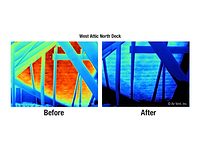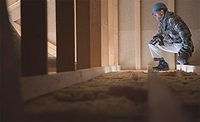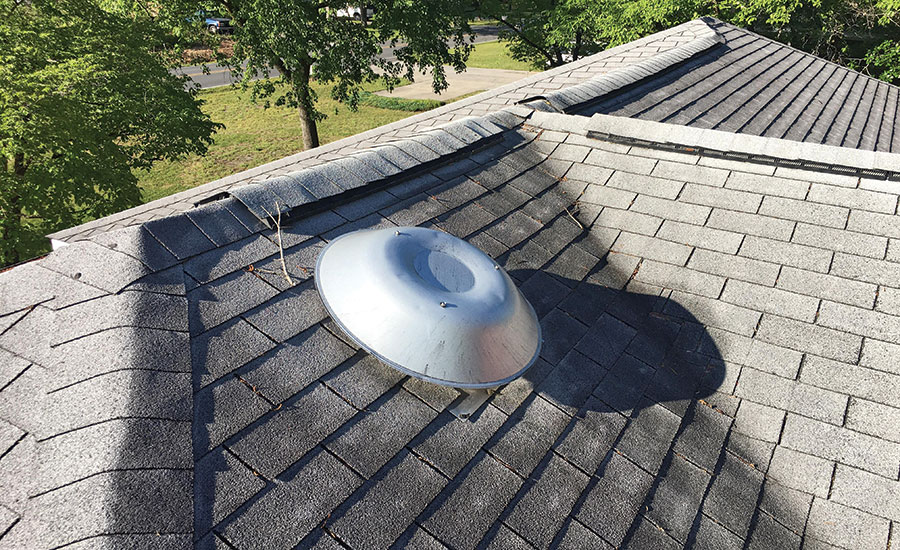What Good are Attic Exhaust Vents
No good without proper intake vents

Ensuring a homeowner has proper roofing ventilation, both exhaust and intake, can lead to positive results for all parties involved.

Ensuring a homeowner has proper ventilation, both exhaust and intake, can lead to positive results for all parties involved.


When attic ventilation gets the attention of the residential roofing contractor, it’s most often the exhaust vents in the spotlight.
This is understandable because the goal of the attic exhaust vents is to get any heat and moisture buildup out of the attic (that is, “exhaust”). That’s exactly what ridge vents, wind turbines, gable louvers, box vents/roof louvers and power fans — the five categories of exhaust vents on the market — are designed to do. That’s why they are an obvious point of focus by the contractor.
But here’s the reality. Exhaust vents without the proper amount of intake ventilation at the soffit/eaves or low on the roof are useless and potentially problematic. We asked attendees of our best practices in residential attic ventilation seminars point blank: Do you tackle intake ventilation when installing attic exhaust vents?
Balanced System
Roofing contractors who have taken the time to understand airflow dynamics realize that to remove hot air and moisture from an attic there must be incoming cooler, dryer air into the attic.
“Absolutely, we install intake vents,” said Trevor Atwell, owner of Atwell Exterior Services LLC, in Greenville, N.C. “You can’t have proper exhaust without proper intake.”
Together, intake and exhaust vents form a balanced attic ventilation system that also helps to fight ice dams in snow climates by keeping the roof deck temperature even so the snow and ice can melt evenly.
“Yes, we install intake vents. You’ve got to have a balanced system,” said Patrick Readyhough, president of Pond Roofing Company Inc., in Fairfax, Va.
Contractors install intake vents with exhaust vents as a regular course of action, or at least ensure the intake ventilation in place is enough to satisfy the needs of the exhaust vents.
“We install intake vents on every project,” said Richard Turner, owner of R. J. Turner Remodeling LLC, of Winston-Salem, N.C. “We stress to homeowners why it is needed and the long-term effects it can have without a balanced system.”
For many roofing contractors, the one-two combination of intake and exhaust has become automatic and second nature. The two just go together.
“Absolutely we install intake vents when installing exhaust vents,” said Jeff Barnett, vice president of Barnett Roofing & Siding Inc., in Canton, Mich. “Attic ventilation is a two-step process. Proper air exchange inside the attic needs both steps to function properly.”
Clayton Putman, owner of Colorado Roofing Solutions in Aurora, Colo., will not install exhaust vents unless the intake vents are installed along with them.
“We do it specifically this way because they work together as a system, and exhaust is ineffective without supporting help from the intake,” he said.
Why Stop Halfway?
Many of the roofing contractors insist on intake ventilation as part of the project when installing exhaust vents because anything less is not finishing the project for the homeowner:
“Yes, we install intake vents because it’s a 50/50 system of airflow when venting attics. If you don’t install the intake vents it’s like doing half of the project and stopping,” said Sue McCollum May, owner of A Better Way Construction and Roofing LLC, in Lincoln, Neb.
“One-hundred percent of the time we install intake ventilation,” said Chris Arrington, vice president of Arrington Roofing, Dallas, Texas. “We always do it right or we don’t do it.”
“We have all the tools on hand to provide intake vents. Even on homes that are 100-plus years old,” said Jeff Heitzenrater, owner of Triple Peaks Roofing and Construction Inc. in Olmsted Falls, Ohio. “The roof-top Edge Vent is our biggest tool for intake ventilation.”
Sometimes the homeowner balks, but roofing contractors persist with their explanation.
“Every chance I get we install intake vents,” said Sabrina Johnson, president of KDCO Home Improvement Inc. of Akron, Ohio. “I offer the reasoning, the proof of why it’s needed and my estimate. I then leave it up to the homeowner if they can afford or want to afford this proper application. I do let them know that if they do not opt for the intake vents it will very likely affect their shingle manufacturer’s warranty in the future.”
Useless and Problematic
Not only are exhaust vents unable to properly remove heat and moisture from the attic without the needed flow of air from intake vents, they can become problematic, and problems often lead to callbacks. Callbacks lead to unhappy customers and lost revenue.
If a non-motorized exhaust vent (ridge vents, wind turbines, roof louvers and gable louvers) is starving for intake airflow it can actually pull air from itself (in testing we’ve seen a ridge vent ingest air from its back side) or from a nearby exhaust vent (a wind turbine or box vent will gladly take air from anywhere, including the wind turbine a few feet down the roofline if intake air from the soffit is not happening). If an exhaust vent is suddenly ingesting air, it could also suddenly be ingesting anything the air is carrying along for the ride: rain, debris, dust, and snow, all entering the attic. That’s not what exhaust vents should be doing.
Motorized exhaust vents (roof-mount and gable-mount power fans) that are lacking the needed intake air can experience premature motor burnout and pull air from the conditioned living space. Neither one of those situations is desirable.
Installation Instructions, Warranty and Code
Never mind that the installation instructions written by the exhaust vent manufacturer clearly state the need for proper intake ventilation, what does the shingle manufacturer’s warranty say?
The full terms of the shingle warranty are tied to proper attic ventilation. The Asphalt Roofing Manufacturers Association, the official representing organization of shingle manufacturers, said the attic ventilation system must be balanced with intake and exhaust vents.
Finally, the International Residential Building Code says to follow the attic ventilation manufacturer’s installation guidelines. It almost must be intentional to overlook the specified, explained need for intake ventilation.
“Yes, we install intake vents every time we install exhaust vents,” said Bastian of Bastian Roofing. “This is a must for proper attic ventilation required from every shingle manufacturer.”
Dale Johnson the general manager of Rock Solid Exteriors in Mount Clemens, Mich., agrees with Bastian.
“Yes, we do install intake ventilation because of the manufacturer’s warranty requirements and to meet local building code,” said Johnson.
And if the homeowner isn’t too concerned about their shingle warranty?
“If after explaining the need for intake ventilation in order to meet code and the shingle manufacturer’s warranty requirements the homeowner is unwilling to have intake vents installed, we insist the homeowner signs off on the project,” said Pike of Campo Roofing.
Always on the Lookout
Sometimes the roof already has enough intake ventilation and only needs a boost with the exhaust. That’s what Matt Cooper, general manager of Redemption Roofing in Montgomery, Texas, found out in his projects.
“Most of the time we do not need to do anything with the intake because of the prevalence of fully vented soffits. Most homes we work on have sufficient intake,” he said, adding that he always checks.
So does Corey Ballweg, owner of Mid Towne Construction Inc. in Cross Plains, Wis.
“If it gives the appearance of being less than required, we will make it a topic of discussion,” he said.
For Jegen of Gorilla Exteriors Contracting, adding the necessary intake ventilation goes together with his overall business approach — an approach that generally produces more referrals, leads and business opportunities.
“My whole reason for being in this business and anything that I do is to improve the situation, the roof system and the curb appeal for the homeowner,” Jegen said. “Then, after the project, the homeowner is talking about my company in a positive manner to family and friends. Doing it the right way usually nets two to three more projects.”
Perhaps Bryan Epley, senior director of business development and sales at Gen 3 Roofing in Centennial, Colo., summarizes the importance of intake vents best:
“We do not always install intake ventilation when installing attic exhaust vents, but we should, and we’ll be focusing on that.”
Intake Vents Boost Your Bottom Line
Many of the roofing contractors we interviewed said including intake vents as part of the overall attic ventilation project leads to increased sales and referrals.
“Including intake vents is an easy way to generate additional revenue while doing the project the correct way,” said Greg Pike of Campo Roofing in Twinsburg, Ohio.
Anecdotally, roofing contractors let us know in no uncertain terms that intake vents can lead to higher profits.
“You’re not just installing new shingles and exhaust vents. You’re installing a total roof system and charging accordingly for it,” said Sandra Daffer, owner of Hawaiian Built Roofing LLC in Boise, Idaho.
More than ever, today’s homeowners take to social media to learn what others are saying about house projects and to do some of the talking themselves. Being on the positive side of the conversation is beneficial to roofing contractors.
“It’s a huge opportunity to set yourself apart from the other ‘order takers’ who just replace the roof and vents as-is and don’t even talk about the improvement of the house,” said Sean Jegen, owner of Gorilla Exteriors Contracting LLC in Shawnee, Kan.
Ron Bastian, owner of Bastian Roofing in Richfield, Wis., said he tells homeowners that it will cost them more in the long run by skipping the intake vents.
“I just explained the importance of balanced attic ventilation to the homeowner and include it in every estimate to separate myself from the other contractors who think they are saving
the homeowner money by not addressing the intake vents,” said Bastian.
Other roofing contractors and experts, like Sean Toms, quality control inspector with S & K Roofing in Eldersburg, Md., commented on the additional benefit of winning multiple jobs.
“Doing the intake vents with the exhaust vents is definitely a business opportunity because we’re helping the customer update the home and reduce home maintenance,” Toms said. “Homeowners will remember this and talk about it.”
Looking for a reprint of this article?
From high-res PDFs to custom plaques, order your copy today!







